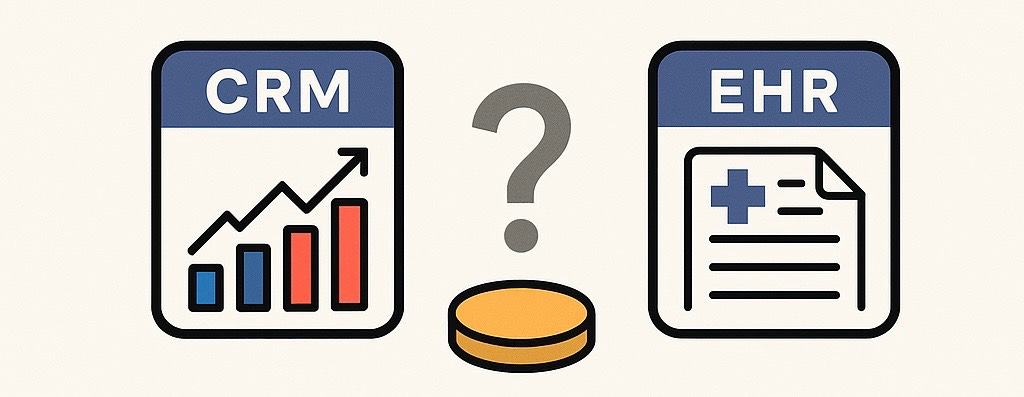CRMs and EHRs: Still stuck in Clunky Systems?
Why both sales and healthcare are drowning in clunky systems — and what AI might do about it.
The Dinner Table Realisation
I was recently invited to a B2B SaaS-only dinner in London, a room full of RevOps and growth operators. The conversation was rich, but what truly stuck with me — and frankly left me both impressed and slightly appalled — was how many manual tasks are still required from SDRs.
Despite all the tooling we claim to have — HubSpot, Mailchimp, Apollo, Gong all the integrations under the sun — SDRs and AEs still spend a huge chunk of their time typing things into boxes. No matter how many dashboards you create or reports you automate, if the right data doesn’t make it into the CRM in the first place, it’s useless.
The Mismatch in CRMs
There’s a fundamental tension in how CRMs are used:
Users (SDRs, AEs): Too busy to input structured data. Focused on the actual selling.
Executives (CROs, RevOps): Relying on clean, structured data to track pipeline, forecast revenue, and measure performance.
So what happens? The highest-performing salespeople often have the worst-looking CRM data. Deals go unlabelled. Notes are missing. Meetings aren’t summarised.
And that’s not a people problem. It’s a system problem.
Wait… This Sounds Familiar
This whole conversation got me thinking about another clunky system that I know all too well: Electronic Health Records (EHRs).
In healthcare, EHRs are the equivalent of a CRM. They store structured information, track histories, and serve as the backbone of hospital operations. But just like CRMs, they rely on their busiest users — clinicians — to input structured, coded data. And surprise: clinicians are also too busy doing their actual job to update a system made by and for administrators.
So again, we have the same gap:
Clinicians: Want to care for patients.
Hospital leadership: Needs clean, coded data for forecasts, budgets, reporting.
Sound familiar?
Why AI Isn’t Fixing It (Yet)
Most AI tools today are designed to fit within this existing clunkiness. Whether it’s a sales assistant pulling notes from Zoom calls, or an AI scribe in a GP surgery, these tools rely on integrating and navigating with clunky systems that were never built for them.
Which begs the question: why are we still trying to retrofit AI into broken infrastructure?
What Would an AI-First CRM Look Like?
Imagine flipping the model.
Instead of AI patching the CRM, what if the CRM was built around AI from day one?
Simple user interface
Conversational inputs, not forms
Dashboards that build themselves
Meeting notes automatically summarised
Metrics auto-calculated in the background
An AI-first CRM wouldn’t need users to type. It would observe, listen, and understand — surfacing insights without constant manual input.
There are already early players moving in this direction — think Folk and Attio. They haven’t yet replaced Salesforce (as more focused on flexible SMEs than Enterprise), but they’ve clearly understood the user pain and are designing around it.
The Same Question for EHRs
In healthcare, we’re seeing a similar early movement. AI scribes are the first path to that automation (just like Gong and Otter were in the sales industry). But again, they’re forced to integrate with EPIC, EMIS, Cerner… systems built decades ago.
There are new entrants — like Semble for smaller private practices. But here again we hit the same tension:
Small teams (1–10 clinicians in primary care)? Flexible enough to adopt new tools.
Large hospitals? Long sales cycles. Enormous switching costs. Risk aversion everywhere. Compliance at core.
So we end up in a chicken-and-egg situation: EHRs won’t change until big institutions adopt something better. But big institutions won’t adopt unless it’s proven at scale.
Will an AI-first interface win in healthcare?
Will a true AI-native interface win in healthcare?
Or will the incumbents — CERNER, Rio, EPIC, etc. — evolve just enough to stay sticky?
Can AI-first platforms build the enterprise features needed to compete? (Forecasting, compliance, integrations, security, coding).
Or will we keep building tools that sit on top of outdated systems — instead of rebuilding them altogether?
Final Thoughts
Maybe we’re just at that awkward moment in the curve — where AI tools are promising, but infrastructure is still catching up.
But if we do manage to rebuild these systems around how users actually work, we might finally see a step-change in productivity. For both sales teams and clinical teams alike.




